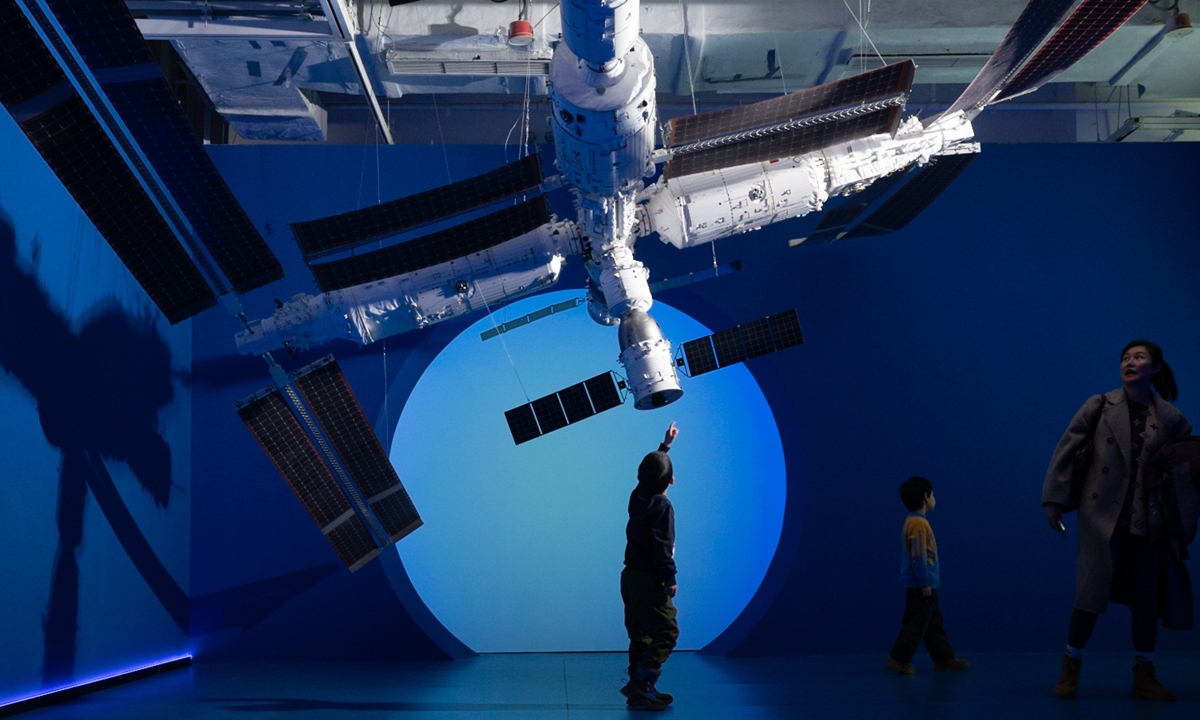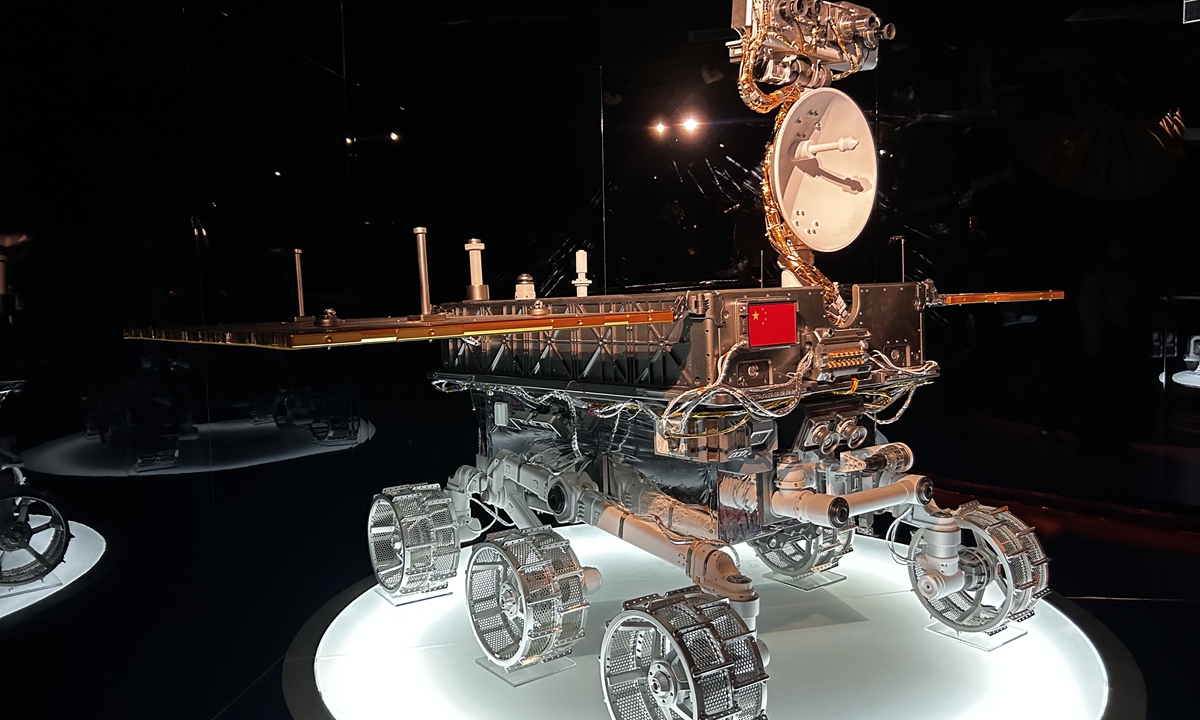
A boy points at the model of the Tiangong space station at the art exhibition Infinity China Aerospace Photo: IC
Including an immersive design called "Rocket Forest," an art exhibition titled
Infinity China Aerospace was recently launched at the Today Art Museum in Beijing, allowing visitors to imitate rocket launchers that can send multiple carrier rockets from China's Long March space vehicle series into the "sky."
Such an intriguing design was achieved through the installation of several high-technological screens revealing real scenes captured during China's rocket launching ceremonies. Experiential settings as such introduced a transformation of the rocket-science "space" IP to collaborate with everyday art consumption and cultural creative industries.
"Good stories need new ways to be told," Liu Yanjun, the curator of the exhibition, told the Global Times.
Cultural connotation Despite the exploration of space being a story shared by many countries in the world, the exhibition is dedicated to depicting China's "originality" in space exploration.
The show starts by introducing ancient Chinese musings about space that started more than 4,000 years ago. Several historical cases are then highlighted to visitors, including the world's earliest astronomical observatory at the Taosi archaeological site in North China's Shanxi Province, as they also learn about Wan Hu, the first man in Chinese history to have designed a chair rocket during the Ming Dynasty (1368-1644).
Different from the West's science-oriented space exploration, such stories reveal how Chinese people merge humanistic and cultural development with the nation's evolving desire to explore the outer space.
Ever since ancient times, "astronomy" in China has never belonged to just a group of science elites, but a part of ordinary people's everyday lives. The "24 Chinese solar terms," for example, were derived from Chinese farmers' observations.
Liu Dejiang, the curator at the museum, told the Global Times that the exhibition attempts to show China's "romantic interpretations" of space culture to spectators.
He also noted that a lot of literary quotations rooted in ancient Chinese philosophies are still sources of inspiration for the country's present-day space industry development.
A total of 12 sets of Chinese spacecraft models are on display at the exhibition including the 1:1 made Yutu rover, also known as the "jade rabbit." It was China's first robotic lunar rover launched to complement the China's Chang'e 3 mission to the moon.
Both "Chang'e," the moon fairy, and the "jade rabbit" are characters from ancient Chinese legends.
The use of ancient Chinese culture to inform the most up-to-date space developments is a prolific part of China's space exploration philosophy.
The name "Queqiao," or the "bridge of magpies," also comes from a Chinese myth but is now the name of China's relay satellite for the Chang'e 4 lunar far-side mission.
As an information "bridge," the "Queqiao" relay satellite was designed by using China's own technologies and is the first probe in the world to have made a soft landing on the far side of the moon.
"All these beautiful Chinese names were not randomly given, but were carefully chosen to match the space devices' functions," Liu told the Global Times, adding that they hope visitors will see the "consistency" in Chinese culture through such displays.

A model of the Yutu rover Photo: Courtesy of Today Art Museum
'Moon in my pocket'
Unlike many standard art exhibitions that tell stories through texts and images,
Infinity China Aerospace stands out by providing visitors with predominantly multisensory "experiences." Aside from "Rocket Forest," a huge mapping projection design was installed, inviting viewers to gain a view of the outer space and the Earth through the eyes of an astronaut.
In the nearly 3,000-square-meter exhibiting hall, experts in niche fields like digital art, animation, VR technology and programming have collaborated to set up displays. Liu, the curator, told the Global Times that such a "team-plus-team" organizing approach was inspired by the mechanism of the film industry.
Liu said the curatorial approach diversifies what viewers can receive from an art show and helps unfamiliar IPs like "Chinese space culture" to engage as many visitors as possible, especially young people.
Despite such exciting experiential designs having successfully enticed many young visitors and children to visit the show, Liu said that merely satisfying aesthetic cravings isn't the true goal of the exhibition. As a cultural consumption provider, Liu said that they want people to be surrounded by Chinese space culture and feel its spirit.
In recent years, with the support of programs such as the China Space Culture Creative Design Competition, a diverse range of space-related creative products such as stationery, clothes, accessories and home decor have been trending in the cultural consumption market.
Taking China Aerospace Science and Cultural Innovation as an example, the company has not only launched aerospace creative products, but has also collaborated with emerging sci-fi writers to launch "Sci-fi x Chinese space" NFT products.
Yu Jiadi, a cultural sociologist, told the Global Times that space culture is of "social importance" in bettering public education as well as encouraging young people to feel the pride and confidence of advanced Chinese technological growth.
"Not every one of us can join top-level aerospace research, but the crossover between the cultural and aerospace industries can enable all of us to have a piece of the 'moon' in our pockets, no matter whether it is a notebook or key ring," Yu told the Global Times.